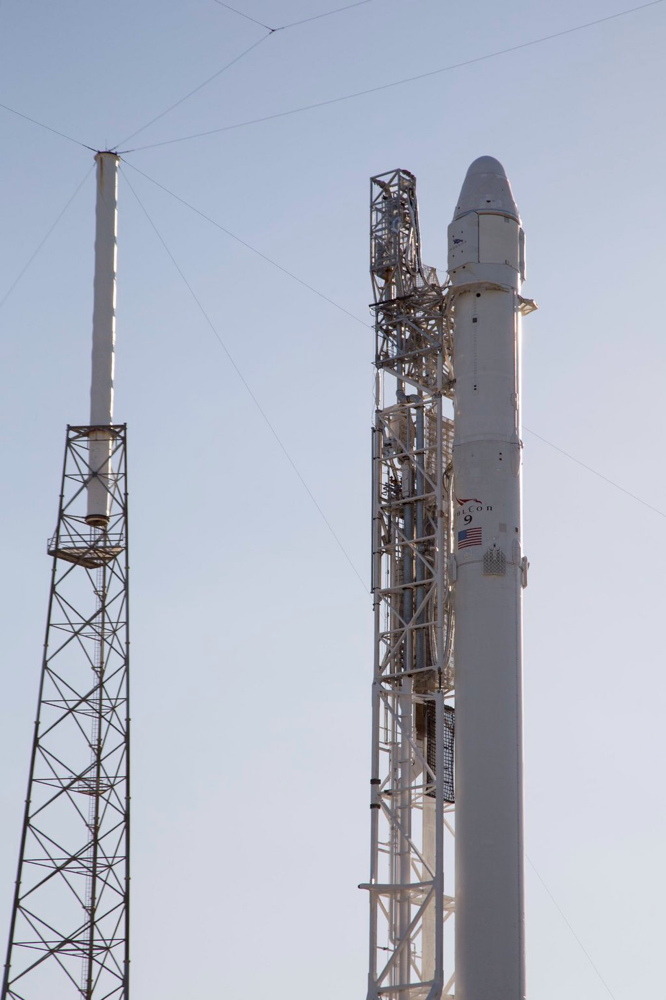SpaceX Conducts Static Fire Test Ahead of Dragon Launch

SpaceX completed a static fire test Tuesday night for Friday's launch of a Dragon cargo spacecraft.
The company didn't disclose the outcome of the test, part of the company's standard preparations for Falcon 9 launches.
If the test didn't reveal any issues, the launch is slated to take place Friday at 4:43 p.m. Eastern, with favorable weather conditions forecast.
The Dragon is carrying more than 3,000 kilograms of supplies and experiments for the station, including an expandable module developed by Bigelow Aerospace. [Florida Today]
More News
Boeing has filed a motion in federal court to block any sale of Sea Launch by the Russian government. The company's lawyers are seeking a preliminary injunction in U.S. district court in California to halt the sale, saying it would further complicate efforts to seek payment from a former Sea Launch partner, Energia, in an ongoing lawsuit. The head of Roscosmos said last month that it had found a buyer for the launch company, but declined to name the buyer or the value of the deal. Sea Launch's two major assets, its command ship and mobile launch platform, remain in the U.S. at the Port of Long Beach. [SpaceNews]
China launched a microgravity science satellite Tuesday. The Long March 2D lifted off from the Jiuquan Satellite Launch Center at 1:38 p.m. Eastern and placed the Shijian-10 satellite in orbit. The spacecraft carries 19 experiments in a variety of fields, including one involving the European Space Agency to study the effects of temperature on pressurized containers of crude oil. The spacecraft will bring some of the experiments back to Earth in about two weeks in a return capsule. [Spaceflight Now]
The head of NASA's Science Mission Directorate will retire this month. NASA announced Tuesday that John Grunsfeld, who has served as associate administrator for science since early 2012, will retire at the end of the month. Grunsfeld is a former astronaut who flew on five shuttle missions, including three to repair the Hubble Space Telescope. Geoff Yoder, Grunsfeld's current deputy, will take over on an acting basis until a permanent successor is named. [SpaceNews]
Get the Space.com Newsletter
Breaking space news, the latest updates on rocket launches, skywatching events and more!
Point-Counterpoint: Should the U.S. change current policy and allow retired ICBM assets be used for commercial launches? Yes, says Scott Lehr of Orbital ATK, who argues that these motors could lower launch costs and make U.S. vehicles more competitive on the international market, while lowering the costs to the government to maintain the motors in storage. No, says George Whitesides of Virgin Galactic, who believes that the current policy restricting the use of those motors should be maintained to avoid "chilling future investment and development" in commercially-developed vehicles. [SpaceNews]
Spaceport America has signed up a new customer to launch from New Mexico. Exos Aerospace signed a five-year partnership to launch its SARGE suborbital rocket from the spaceport, with the first launch tentatively planned for late this year. The company will eventually develop a dedicated facility at the spaceport once its launch rate increases to a certain, unspecified level. Exos includes some of the same people and technology as the former Armadillo Aerospace, which also carried out launches at the spaceport. [Albuquerque Journal]
A barrage of asteroids and comets might have made Mars more habitable early in its history. Models of the planet four billion years ago, during a burst of asteroid and comet impacts known as the Late Heavy Bombardment, show that the collisions would have heated up subsurface ice enough to melt it, even if the planet's atmosphere was as cold and thin as it is today. Those more habitable conditions, though, would have faded within a few million years after the end of the bombardment. [Cosmos]
You can go to space without leaving your hotel room, provided you're in the right hotel in Zurich. The Kameha Grand Hotel there features a "space suite" designed by German artist Michael Najjar. The space theme permeates the suite's design, from light fixtures designed to look like engine nozzles to a spacesuit glove protruding from a wall as a place to hold your keys and phone. "Basically, everywhere you look, there's space. Literally," says a review of the room. The space suite is one of several themed rooms in the hotel. [Forbes]
Home, The Final Frontier
"After exploring strange new worlds and seeking out new life in the universe, I can now boldly go where I've rarely gone before: home."
– John Grunsfeld, in a NASA statement Tuesday announcing his plans to retire as the associate administrator for science at the end of this month.
This story was provided by SpaceNews, dedicated to covering all aspects of the space industry.
Join our Space Forums to keep talking space on the latest missions, night sky and more! And if you have a news tip, correction or comment, let us know at: community@space.com.

Jeff Foust is a Senior Staff Writer at SpaceNews, a space industry news magazine and website, where he writes about space policy, commercial spaceflight and other aerospace industry topics. Jeff has a Ph.D. in planetary sciences from the Massachusetts Institute of Technology and earned a bachelor's degree in geophysics and planetary science from the California Institute of Technology. You can see Jeff's latest projects by following him on Twitter.










